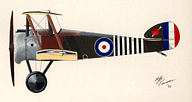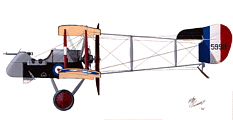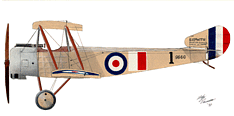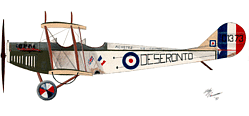Bob Pearson's Aircraft Profiles
The following profiles were created by Bob Pearson
(bpearson@kaien.com).
His comments are below:
 Felixstowe F.3 N4258
Felixstowe F.3 N4258
Based at Felixstowe NAS in the Autumn of 1918.
According to Austin Robinson (who should know as he flew them) the painting
of the Felixstowes was entirely an affair of the summer and autumn 1918. And
that they were painted with dazzle schemes, not as an attempt at camouflage,
but the exact opposite - to make them recognizable at a glance in the air
and (as importantly) to be able to see a downed boat at sea. The first
example of the benefit of this practice took place on June 4 1918, when
three
Felixstowe based boats and two from Great Yarmouth were involved in a fight
with German seaplanes. One of the Yarmouth boats (either N4298 or N4289) was
painted in red/yellow stripes and was the only one easily recognized of the
five boats concerned. After this the others crews were allowed to paint
their boats in similarly garish colours and patterns.
Further reading on the Felixstowe boats can be found in the following issues
of C&C (GB/INT)
- 11/1 Recognition of First War Flying Boats: Austin Robinson; also includes
corrections to errors on recognition in other published sources.
- 21/4 HIgh Visibility Colour Schemes: Adrian Vicary; has drawings and photos
of 16 dazzle boats
- 22/2, 22/3, 24/1 all contain corrections to the Vicary article
- 27/4 Aspects of the RNAS: Peter Wright; FSL Boultings time on various boats
at Felixstowe NAS

 The Dragon/Crocodile markings for the Bohme/Lademacher Albatros C.III
C.766/16 in both 1/48 and 1/72 scales. Although they appear somewhat large
when opened up to full size, this is just your screen showing all the dots
and they should print at scale size.
The Dragon/Crocodile markings for the Bohme/Lademacher Albatros C.III
C.766/16 in both 1/48 and 1/72 scales. Although they appear somewhat large
when opened up to full size, this is just your screen showing all the dots
and they should print at scale size.
 Albatros C.III C.766/16
Albatros C.III C.766/16
Ltn Erwin Bohme/Ltn Lademacher
Kasta 10
Kavel Aerodrome, Russian Front
August 1916
One of the more striking markings carried by any aircraft in WW1 was the
dragon marked Albatros C.III flown by Bohme/Lademacher of Kasta 10 on the
Russian front during the Summer of 1916. Until recently it was assumed that
both sides of the aircraft featured the dragon, however photos in the
 possession of Dr.-Ing Niedermeyer show that the port side was in fact a
crocodile. Besides the dragon & crocodile, the aircraft also featured small
white silhouettes of Russian aircraft being chased by the reptiles. That on
the port side being a pusher, while the starboard side had a tractor. The
starboard side also has a rack for flares as well as the rigging notes in a
small square below the observor's cockpit. The dark wheel covers are
interpreted as black but could have been red.
possession of Dr.-Ing Niedermeyer show that the port side was in fact a
crocodile. Besides the dragon & crocodile, the aircraft also featured small
white silhouettes of Russian aircraft being chased by the reptiles. That on
the port side being a pusher, while the starboard side had a tractor. The
starboard side also has a rack for flares as well as the rigging notes in a
small square below the observor's cockpit. The dark wheel covers are
interpreted as black but could have been red.
For more information on Bohme, see the articles in OVER THE FRONT volumes
5/1, 6/4 and 12/2.
Thanks to Greg VanWyngarden for providing the photos, and to OVER THE FRONT
(www.overthefront.com) for allowing me to
make use of the profiles here.
 Sopwith Camel B6313
Sopwith Camel B6313
Major William George Barker
OC, No 139 Sqn RAF
September 1918
B6313 went through many changes to it's appearance during it's year of
combat flying. Initially it had No.28 Sqn's white square and wheel covers
and flight number of '1' with a small 'C'. Possibly changed to 'N' when
No.28 went to Italy. When Barker went to No.66 Sqn, B6313 most likely had
their markings of a vertical bar in front of the roundel and a horizontal
one behind it, but no photo has been found. Upon going to No.139 Sqn B6313
had two white bands behind the roundel, changing to 4 white and 3 black and
later expanding to 7 white and 6 black extending from the roundel to the
tailplane. B6313 also had an arrow through the heart on it's fin. At some
point this was repainted as it is shown with the arrow facing both fore and
aft at different times. Here B6313 is depicted in its ultimate appearance at
No.139 Sqn RAF in September 1918.
 RAF SE5a D'213
RAF SE5a D'213
2/Lt PD Learoyd
No.40 Sqn RFC
Bruay Dunes Aerodrome
Early 1918
 Nieuport 17 B'3459
Nieuport 17 B'3459
Captain Philip Fletcher Fullard
No.1 Sqn RFC
Bailleul Aerodrome
September 1917
PF Fullard is one of the many little known and unsung aces of the First
World War. During only 5 1/2 months in 1917 he claimed 42 victories, before
being withdrawn from combat after breaking his leg in a football game with
another unit. This injury kept him from flying for over a year and had not
the Armistice intervened he would have taken command of one of the first of
the new Martinsyde F.4 Buzzard squadrons.
Fullard scored 17 of his victories while flying B'3459. Although shown as
red, the squadron marking of a vertical bar may have been black.
 deHavilland DH2 5998
deHavilland DH2 5998
Captain John Oliver Andrews
OC, A Flight
No.24 Sqn RFC
Late 1916
JO Andrews downed 5 EA while flying DH2 5998, one of which was flown by
Stephan Kirmaier, OC of Jasta 2 on November 22 1916. Andrews eventually
ended the war with a total of 12 victories and command of No.209 Sqn.
 RAF RE8 A'3843
RAF RE8 A'3843
No.42 Sqn RFC
August 1917
 Sopwith 1 1/2 Strutter 9660
Sopwith 1 1/2 Strutter 9660
FSL Charles H S Butterworth
No.3 Wing RNAS
Luxeuil-les-Bains Aerodrome
October 1916
No.3 Wing RNAS was sent to France in June 1916 to provide the British
component of a combined Franco-British strategic bombing force to raid
Germany. After a slow buildup
of strength due to resources being diverted to the RFC after the opening of
the Somme offensive, the first major raid took place on 12 October 1916. On
this date 22 British and 34 French attacked the Mauser rifle factory at
Oberndorf, Germany.
One of the three RNAS aircraft lost was 9660 flown by CHS Butterworth, a
Canadian from Ottawa. Butterworth had been attacked by a Fokker D.II flown
by Vzfw Ludwig Hanstein and forced to land at an aerodrome near Freiburg
with a slight neck wound as well as damage to his engine and was taken POW.
The appearance of 9660 is interesting in that it is at odds to the rest of
No.3 Wing in having a CDL fuselage and PC10 wings and tail surfaces, whereas
all the others I have seen are PC10 overall. The red/white individual
marking repeated on both stabilizers and was a feature of the aircraft of
this unit.
 Bristol F2b D8084
Bristol F2b D8084
No.139 Sqn RAF
Villaverla Aerodrome
September 1918
Originally formed in March 1918 as 'Z' Flight and attached to No.34 Sqn in
Italy for long range reconnaissance duties. By July 1918 a second flight had
arrived and the combined unit was known as No.139 Sqn RAF. The original
marking of two vertical white bands soon gave way to four white and three
black bands and ultimately expanded to the 12 and 11 depicted here on D8084.
This aircraft also carried a spanwise w/b/w stripe between the upperwing
 Curtiss CN-4(Can) C1373
Curtiss CN-4(Can) C1373
No.90 CRS RAF(Canada)
Camp Rathbun Aerodrome
Deseronto, Ontario
1918
Painted up as part of a war bond drive C1373 provokes many questions. First
of which is what unit does C1373 belong to? The fuselage roundel
(occasionally repeated under the fuselage as well), rudder stripes and r/w/b
square on the fin point to it's use by No.90 CRS/CTS RFC/RAF(Canada) at
Rathbun in 1918. However the red (or black?) tips to the white elevator
could be from prior (or present service) with one of many number of other
units.
The overall white colour is based on tonal values. In addition to the
fuselage the radiator and cowl louvres were also white. While the elevators
were white with red (or black) tips. There was a white stripe on the
ailerons between the first and second rib from the tip. The propellor may
have been r/w/b from the centre out with black on the rear side (I chose to
leave this off the profile as I couldn't tell for sure). Besides the crossed
flags and message ACHETEZ UN COUPON on the port side there is the message
BUY A BOND on the starboard side under the rear cockpit. C1373 possibly
carried roundels under the top wing as well. Wheel covers were divided into
six equal portions of r/w/b.
Deseronto, Ontario is the location of the Camp Rathbun and Camp Mohawk
aerodromes.
Thanks to Jim Lyzun for use of his photographs in the development of this
profile. Notes on RFC/RAF(Canada) markings are from C&C(GB) 15/3.
 Albatros D.V
Albatros D.V
Ltn Franz Müller
Jasta 11
Summer 1917
Formerly of Fl.Abt.18, Müller served with Jasta 11 From 15 July 1917 until
his death in a flying accident on 27 October 1917. His only victory was over
a 'Sopwith' on 14 August. Müller's D.V features the typical Jasta 11
markings of the Summer 1917 period of Red nose, wheels and struts with the
pilots personal colours on the rear fuselage and/or tail.
 Return to The WWI Images Page
Return to The WWI Images Page
 possession of Dr.-Ing Niedermeyer show that the port side was in fact a
crocodile. Besides the dragon & crocodile, the aircraft also featured small
white silhouettes of Russian aircraft being chased by the reptiles. That on
the port side being a pusher, while the starboard side had a tractor. The
starboard side also has a rack for flares as well as the rigging notes in a
small square below the observor's cockpit. The dark wheel covers are
interpreted as black but could have been red.
possession of Dr.-Ing Niedermeyer show that the port side was in fact a
crocodile. Besides the dragon & crocodile, the aircraft also featured small
white silhouettes of Russian aircraft being chased by the reptiles. That on
the port side being a pusher, while the starboard side had a tractor. The
starboard side also has a rack for flares as well as the rigging notes in a
small square below the observor's cockpit. The dark wheel covers are
interpreted as black but could have been red.
 Felixstowe F.3 N4258
Felixstowe F.3 N4258
 The Dragon/Crocodile markings for the Bohme/Lademacher Albatros C.III
C.766/16 in both 1/48 and 1/72 scales. Although they appear somewhat large
when opened up to full size, this is just your screen showing all the dots
and they should print at scale size.
The Dragon/Crocodile markings for the Bohme/Lademacher Albatros C.III
C.766/16 in both 1/48 and 1/72 scales. Although they appear somewhat large
when opened up to full size, this is just your screen showing all the dots
and they should print at scale size.
 Albatros C.III C.766/16
Albatros C.III C.766/16 Sopwith Camel B6313
Sopwith Camel B6313 RAF SE5a D'213
RAF SE5a D'213 Nieuport 17 B'3459
Nieuport 17 B'3459 deHavilland DH2 5998
deHavilland DH2 5998 RAF RE8 A'3843
RAF RE8 A'3843 Sopwith 1 1/2 Strutter 9660
Sopwith 1 1/2 Strutter 9660 Bristol F2b D8084
Bristol F2b D8084 Curtiss CN-4(Can) C1373
Curtiss CN-4(Can) C1373 Albatros D.V
Albatros D.V